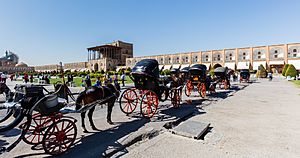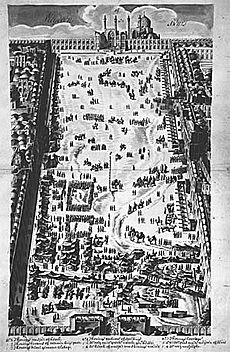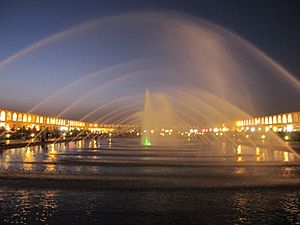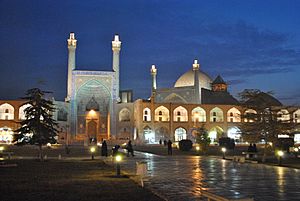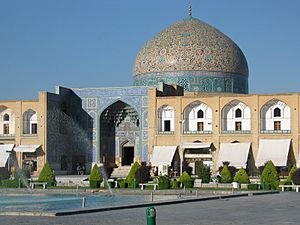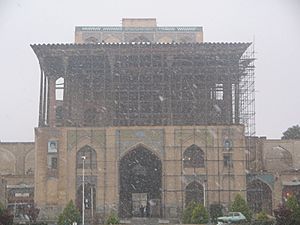Naqsh-e Jahan Square facts for kids
| UNESCO World Heritage Site | |
|---|---|
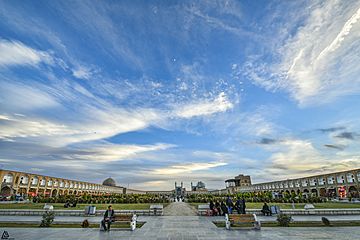
Naghsh-e Jahan square
|
|
| Location | Isfahan, Isfahan Province, Iran |
| Criteria | Cultural: (i)(v)(vi) |
| Inscription | 1979 (3rd Session) |
Naqsh-e Jahan Square (Persian: میدان نقش جهان Maidān-e Naghsh-e Jahān; meaning "Image of the World Square") is a huge, historic square in the center of Isfahan, Iran. Before 1979, it was known as the Shah Square. It was built between 1598 and 1629. Today, it is a very important historical place and is recognized by UNESCO as a World Heritage Site.
The square is about 160 meters (525 feet) wide and 560 meters (1,837 feet) long. This makes it one of the largest city squares in the world! Buildings from the Safavid era surround it.
On the south side, you'll find the Shah Mosque. The Ali Qapu Palace is on the west side. The Sheikh Lotf Allah Mosque is on the east side. And on the north side, the Qeysarie Gate leads into the famous Isfahan Grand Bazaar.
Today, the important Muslim Friday prayer (Namaaz-e Jom'eh) is held in the Shah Mosque. The square is even shown on the back of the Iranian 20,000 rials banknote!
Contents
Why was Naqsh-e Jahan Square built?
In 1598, Shah Abbas decided to move the capital city of his empire. He moved it from Qazvin to Isfahan. He wanted to make Isfahan a grand new capital. Isfahan was a good choice because it had the Zāyande roud river, which means "The life-giving river." This river made the area fertile, like an oasis in a dry land.
Shah Abbas also wanted to protect his capital from enemies like the Ottomans and Uzbeks. Moving the capital to Isfahan helped him control the Persian Gulf, which was important for trade with European companies.
The main architect for this huge project was Shaykh Bahai. He planned two major parts for the city: the Chahar Bagh avenue and the Naqsh-e Jahan Square.
Before Shah Abbas, different groups in Persia had a lot of power. Shah Abbas wanted to bring all the power to himself. Building Isfahan as a grand capital helped him do this. The square was designed to bring together three main powers in one place:
- The power of religion, shown by the Shah Mosque.
- The power of merchants, shown by the Imperial Bazaar.
- The power of the Shah himself, living in the Ali Qapu Palace.
What was the Royal Square used for?
The square was a place where the Shah and the people could meet. It had two stories of shops all around it. At the northern end, you could find the Imperial Bazaar. The square was always busy with entertainment and business. People from all over the world came here.
Isfahan was an important stop on the Silk Road. This meant goods from places like Portugal and China came to the city. Merchants in the square were very good at trading these goods.
European visitors were very impressed by the Royal Square. One visitor, Pietro Della Valle, even said it was better than the Piazza Navona in Rome!
During the day, many tents and stalls filled the square. Tradesmen paid rent to the government to sell their goods. There were also entertainers and actors. If you were hungry, you could buy cooked food or melon slices. Water carriers gave out free water, paid for by the shopkeepers.
At the entrance to the Imperial Bazaar, there were coffee-houses. People could relax there with coffee and a water-pipe. You can still find similar shops today, but now people mostly drink tea instead of coffee.
The square was also cleared for big public events and parties. One important event was Nowruz, the Persian New Year. The national Persian sport of polo was also played in the square. Shah Abbas could watch the games from his palace. The marble goal-posts he set up for polo are still there today!
Under Shah Abbas, Isfahan became a very diverse city. People from Turkey, Georgia, Armenia, India, China, and Europe lived there. Shah Abbas even brought 300 Chinese artists to teach how to make porcelain. Many Indians worked as merchants and money-changers. Europeans came as merchants, missionaries, artists, and even soldiers.
You might wonder why the mosque in the square doesn't face Mecca directly. When you enter the Shah Mosque, you make a small turn to the right. This turn makes sure the main part of the mosque faces Mecca. Shaykh Bahai planned it this way so that the beautiful dome of the mosque would always be visible from anywhere in the square. If it faced Mecca directly, the tall entrance might have hidden the dome.
Shah Mosque: A Grand Building
The most important building in Naqsh-e Jahan Square was the Shah Mosque. It was built to be the main mosque for Friday prayers, replacing an older one. Shaykh Bahai designed it to be very grand, with the largest dome in the city. He also planned for a religious school and a winter mosque to be built next to it.
Sheikh Lotfollah Mosque: The Private Mosque
The Lotfollah Mosque was the first of the four main buildings around the square to be built. It was a private mosque for the royal family, unlike the Shah Mosque, which was for everyone. Because it was private, it doesn't have any minarets (tall towers) and is smaller.
For a long time, most Westerners didn't even notice this mosque, and ordinary people couldn't go inside. Centuries later, when it opened to the public, people could finally see how beautiful it was. Shah Abbas made it a special place for the ladies of his royal family. The tile-work inside is incredibly detailed and even more beautiful than the tiles on the Shah Mosque.
Ali Qapu Palace: The Royal Entrance
The Ali Qapu Palace is like a grand entrance to the huge royal living area of Safavid Isfahan. This area stretched from Naqsh-e Jahan Square all the way to the Chahar Bagh Boulevard. The name "Ali Qapu" means "Exalted Portal" or "Royal Threshold." This name was chosen to compete with the Ottoman Empire's famous court name, "Sublime Porte."
This is where the Shah would welcome important visitors and foreign ambassadors. Shah Abbas celebrated the Persian New Year (Nowruz) here for the first time in 1597.
The Ali Qapu is a large, rectangular building, about 48 meters (157 feet) high, with six floors. It has a wide terrace at the front with a beautiful ceiling supported by wooden columns.
The sixth floor was used for royal parties and banquets. It has the largest rooms. The walls of the banquet hall are decorated with designs of different cups and vessels. This floor was also called the "music room" because musical groups would perform and sing there. From the upper levels, the Safavid ruler could watch polo games, military drills, and horse races happening in Naqsh-e Jahan Square below.

The Imperial Bazaar: A Shopping Wonderland
The Bazaar of Isfahan is a historic market and one of the oldest and largest bazaars in the Middle East. Even though the current buildings are from the Safavid era, some parts are over a thousand years old, from the Seljuq dynasty. It's a long, vaulted street, about two kilometers (1.2 miles) long, connecting the old city with the new.
See also
 In Spanish: Plaza de Naqsh-e Yahán para niños
In Spanish: Plaza de Naqsh-e Yahán para niños
- Ganjali Khan Complex
- Iranian architecture
- List of city squares by size
- Naqsh e jahan derby
- Safavid architecture
- UNESCO World Heritage Sites


